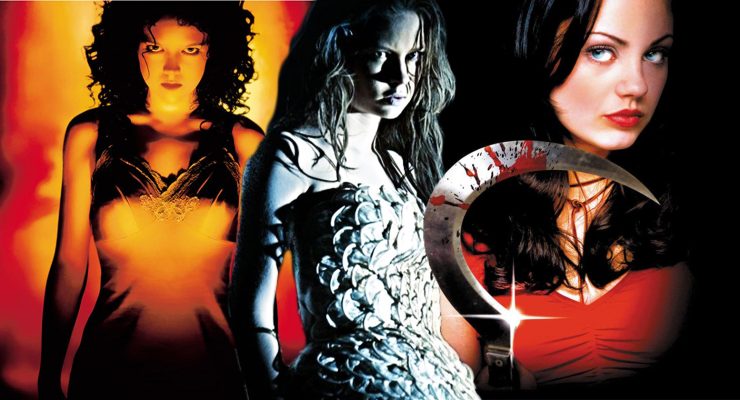Monos, 2019.
Directed by Alejandro Landes.
Starring Sofia Buenaventura, Moises Arias, Julian Giraldo, Paul Cubides, Karen Quintero, Julianne Nicholson, Deiby Rueda, Sneider Castro, Laura Castrillón and Wilson Salazar.

SYNOPSIS:
A gang of child soldiers are left adrift in the Colombian jungle, far away from any adult authority to guide their violent antics.
Sometimes, it’s nice to ease in to a film festival with something cosy – a glitzy star vehicle for an established name, perhaps, or a cosy comedy with some gentle laughs. Monos is not that film. This is a muscular, surreal drama that exists in a world of constant unease. It’s a film that lulls its audience into a disorientated and suggestible state, plunging them into a micro-society that has been cast adrift entirely – left to float inexorably into the Colombian jungle’s heart of darkness.
The title refers to the troupe of child soldiers at the centre of the story, nominally overseen by the diminutive but musclebound adult military man Messenger (Wilson Salazar, a former real-life rebel with guerrilla group FARC). They’re devoted to “The Organization” and their “cause”, without really seeming to know what that is. Wolf (Julian Giraldo) is their leader and the only one who seems to have a romantic attachment, with colleague Lady (Karen Quintero). The rest of the group are a mix of hardened fighters like Bigfoot (Moises Arias) and cub recruits like Rambo (played by female performer Sofia Buenaventura). For a while, their sole mission seems to be to keep a cow alive while watching an American hostage (Julianne Nicholson), but they are soon driven rogue when opposing fighters force them into the rainforest.
There’s something nebulous and meandering about Monos, but it’s precisely that lack of direction that gives Alejandro Landes’ film its intense power. Mica Levi’s unorthodox soundscape – there’s as much gentle whistling as there is raucous cacophony – is in many ways the star of the film, conjuring a palpable sense of unease that is matched by the occasionally hallucinogenic visuals. This world is rendered in stark colour by DP Jasper Wolf, whether it’s the greens and browns of the jungle or the vibrant red of a flare during a cult-like late night party around a bonfire.
Landes utilises mostly non-professional actors for the young characters, which only serves to enhance the inherent danger of the story – kids thrown out into a high-pressure environment to craft their own ersatz power structure. William Golding’s seminal Lord of the Flies is an obvious touchstone, with the presence of a pig’s head on a stick making the link between the two stories explicit. There’s an unsettling contrast drawn between scenes of the kids being ordinary teenagers – they awkwardly make out and prat around doing beatboxing and somersaults – and those of them wielding heavy firepower and carrying out military drills.
This is a society that’s in constant flux, with Moises Arias’ Bigfoot making moves for control. Arias, who has been so brilliant in very different American films including The Kings of Summer, Ender’s Game and Five Feet Apart, is the standout of this movie once again. Here performing in the Spanish language – his parents are Colombian and he was raised bilingual – Arias is a powder keg of barely repressed masculine energy and aggression. His eyes are wild and he carries himself with a perpetual sense of danger, as if a violent eruption is never more than a few moments away.
Landes, however, is not keen to give his viewers the catharsis of bloodshed and confines his explicit violence to isolated, shocking scenes of senseless brutality. There are more moments like the one in which a fighter, wielding an AK-47, solemnly tells the person she’s threatening that she “wants to dance on television”, as if she has suddenly realised her age, like the sobbing kids at the end of Golding’s novel. It’s yet another unbalancing touch in a movie that recognises the incredible power of disorientation. Every time the film seems to click on to an established cinematic track, it squirms free of its bearings and reforms into something different.
This is certainly true in the final third, which takes a delightfully unexpected diversion into the quiet serenity of a more everyday existence. I certainly never expected to learn so much about gummy bears. After 90 minutes of quasi-fantasy madness, off-kilter with the real world, the film pulls everything together with a final shot that appears to break the fourth wall. In an instant, the story is grounded with a stark gut punch of humanity. For many children all over the world, this surreal, dangerous existence is not a fiction – and Landes wants his audience to feel that right to their bones.
While the slippery tone and oppressive sense of dread might not be for everyone, those willing to dive headlong into Landes’ world will be rewarded with a film of quite extraordinary power and flair.
Flickering Myth Rating – Film: ★ ★ ★ ★ / Movie: ★ ★ ★ ★
Tom Beasley is a freelance film journalist and wrestling fan. Follow him on Twitter via @TomJBeasley for movie opinions, wrestling stuff and puns.












